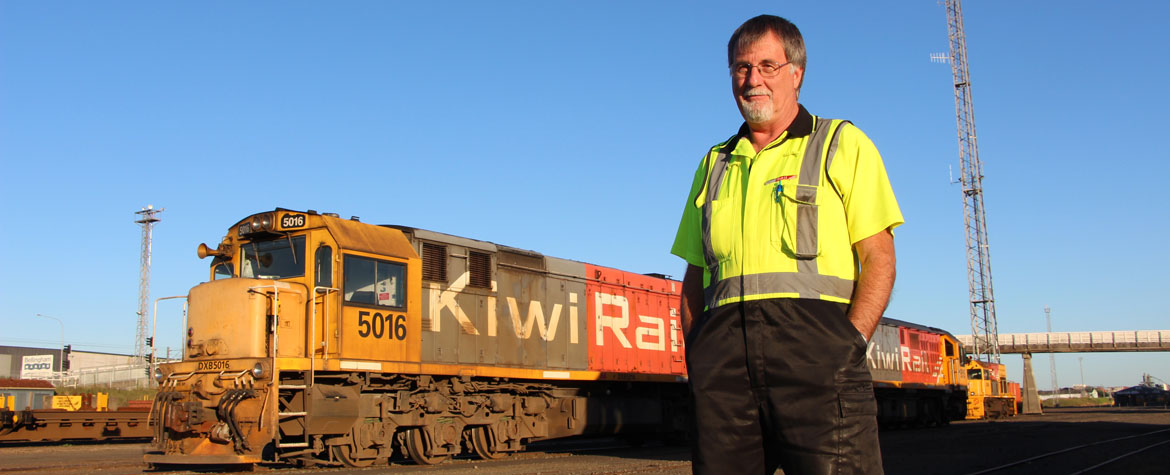
The ripple effect
Monica Tischler investigates what's being done to address the growing number of railway fatalities.
The last memory train driver Robert Neale has of the man fatally hit by his train is of the driver’s hand on his gear stick, desperately trying to reverse the car off the track.
Robert could see the driver from the cabin of his 2,000-ton, one-kilometre-long freight train, which was travelling at about 80kms an hour through a rural area north of Auckland. But the driver didn’t see Robert until it was too late.
Robert could not stop in time. In fact, trains at that weight and speed can keep moving for up to a kilometre after the driver slams on the brakes.
“It’s the sound of the impact that stays with me,” he says. “I was sitting there, having a good day when ‘bang’; it just happened out of the blue.”
It’s one of three fatal crashes the Auckland-based KiwiRail train driver has had over the 12 years he’s transported goods along New Zealand’s tracks. There have been “countless” near misses.
Statistics from the New Zealand Transport Agency confirm 32 train and vehicle collisions and just less than 300 near misses last year.
The growing concern lies with pedestrian safety. Several deaths in the past two years have involved the use of headphones around railway tracks.
Last year, eight people, including seven pedestrians and one cyclist, were killed at level crossings; the highest number in eight years. This year has already seen four deaths, including a West Auckland teenager in April. Police say he was running with headphones so didn't hear the train coming and crossed the tracks in front of it.
Since records first began more than 20 years ago, pedestrian and train collisions and near misses have increased both nationally and globally whereas, while it’s still a concern, particularly in rural areas, vehicle collisions with trains are decreasing.
As a result, KiwiRail is reviewing its method of identifying risks at level crossings to help prioritise crossings for upgrades.
Another factor is the Transport Accident Investigation Commission’s decision last year to include level crossings on its watchlist, along with the likes of the Robinson helicopter which has claimed several lives in recent crashes.
KiwiRail Group General Manager Assets, David Gordon, says the focus is on making pedestrian level crossings at railways safer and more visible.
“There are more people walking around wearing headphones, which is distracting; that’s where the accidents are happening,” he says.
Every year, KiwiRail upgrades approximately eight crossings nationwide. Its current focus is to install flashing LED lights in the ground just before level crossings. This is being trialled in four places, including Wellington, Paraparaumu and Rangiora, with more sites to come if the lights prove effective. The initiative will hopefully bring pedestrians distracted by headphones or smartphones back to reality.
Another initiative is the use of active ‘Expect Train’ signs. These lit-up signals alert motorists, particularly in rural areas, before crossing some of New Zealand’s crossings protected by Stop and Give Way signs but not bells, lights or barriers. The signs are being trialled at crossings in Palmerston North, Marton and Featherston, in the lower North Island, and are designed to reduce driver complacency.
David says the cost of installing pedestrian LEDs and active ‘Expect Train’ signs is about $4,000 per crossing, compared to $160,000 to kit out a crossing with barriers, bells and flashing lights.
Money for these safety upgrades comes from three sources: KiwiRail pays half, NZTA a quarter and local councils cover the remainder.
“We believe we’re better to go with small and cheaper initiatives at lots of crossings, rather than big things at a few,” he says.
While the main focus is on urban pedestrian and rural driver safety, another alarming issue has KiwiRail’s attention: impatient drivers are breaking barrier arms. Every week, particularly in Auckland metropolitan areas, about five barriers are broken.
KiwiRail is considering options, including replacing the zigzag design with barrier arms that lower straight across the road so vehicles are unable to weave through once the arms are down.
While the solution isn’t yet clear, the message is crystal: “It cannot go on; people will be killed or badly hurt,” David says.
The AA urges drivers to slow down, be ready to stop and check for trains at every level crossing, even if there are no bells or lights going off. Because of its size, a train can be travelling much faster than it appears to be, so never try to beat an oncoming train.
David urges pedestrians and drivers to take a moment of care before crossing a track and to consider the “ripple effect.”
“If a person is killed on a crossing, life will never be the same for not only their family and friends, but also the driver who hit them and those at the scene. All will be affected; the ripple of impact goes a long way,” David says.
Robert, who’s not only a train driver but a husband and father of two, agrees. “After each fatal crash I have rung my wife as soon as I could and she’s just burst into tears. It has an impact on the whole family.”
Reported by Monica Tischler for our AA Directions winter 2017 issue
